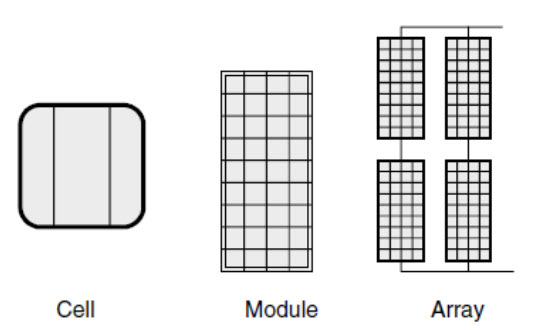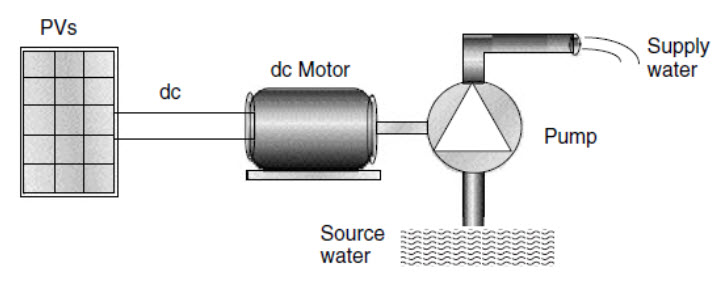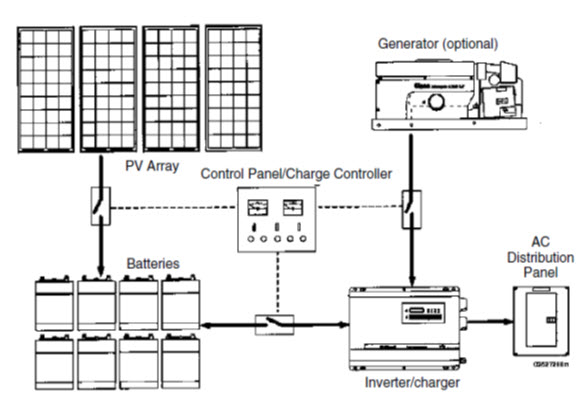Site pages
Current course
Participants
General
Module 1. Design and operational parameters
Module 2. Performance evaluation and maintenance a...
Module 3. Performance evaluation and maintenance a...
Module 4. Performance evaluation and maintenance a...
Module 5. Performance evaluation and maintenance a...
Module 6. Performance evaluation and maintenance a...
Module 7. Biodiesel utilization in CI engines
Lesson 20. Components of Solar Photovoltaic systems
Electricity can be generated through solar photovoltaic systems – a promising option to generate electricity directly from solar radiation. Individual solar cells are connected to from modules of photovoltaic system and more modules form system of array.

Applications of solar photovoltaic systems
Water pumping
Water can be pumped from bore wells for irrigation, residential uses etc. using solar photovoltaic systems.

Lighting
Solar photovoltaic systems are commonly used for lighting in residences, highway signs, street lights, recreational vehicles, remote villages and schools and marine navigational buoys.
Communications
Power generation through SPV can be applied in communications systems like relay stations, emergency radios, mobile phone applications, satellites etc.
Refrigeration
Solar based refrigeration systems are adopted in medicine storage, recreational uses, storage of commercial products in remote areas etc.
Utility grids
Power production in the capacity of kW or MW scale is being started in various locations using solar PV systems.
Household applications
Solar PV cells are used in lighting and fans of houses, lanterns, ventilation fans, televisions, stereos and other applications.

Advantages of PV system
The major advantages of solar photovoltaic systems are
-
Reliability : Solar photovoltaic systems are not having any moving parts, effects little maintenance when compared to other systems of power generation.
-
Modularity : The capacity addition in photovoltaic systems is easy for meeting out any higher power requirements.
-
Environment : The SPV mode of power production do not release any pollution and hence protect the environment.
-
Hybridization : Combining PV systems with any type of power production systems such as wind, hydro, diesel etc. is easier to charge batteries and provide additional power on demand.
-
Cost : In situations where the transmission cost of power is higher to remote locations, using conventional power production system, a PV system may be a better option with most cost-effective power supply system.
Sizing of PV systems
In sizing of solar photovoltaic system, the first step is to assess the daily energy consumption based on daily loads. Determination of total energy consumption may be carried out as follows.
Multiply the capacity (watt) of the appliance by the number of hours of operation in a day.
If the wattage of the appliance is not provided in the appliance spec plate, the wattage has to be calculated by multiplying the specified current and voltage of the appliance.
Sum the total daily energy consumption in watt-hours.
As the SPV systems are rated by peak watt (power production at 1000 watts per square meter of solar radiation).
Divide the total watt hr requirement by PV rating (Wh).
Divide with 0.8 to consider the battery efficiency.
Multiply with 1.2 for overlooked loads.
Divide by module wattage (say 37 watt)
Example : Calculate the daily total energy consumption and find out the number and wattage of the PV systems if all the energy requirement will be met with solar PV systems.
The loads are 2 lamps of 15 wattages for 2 hours of daily usage, 25 wattage radio for daily 2 hours, 30 wattage of VCR for daily 0.5 hours.
Components in SPV systems
In addition to PV modules, Balance –of-system (BOS) has to be attached. This BOS includes, battery charge controllers, batteries, inverters (for loads requiring alternating current), wires, conduit, a grounding circuit, fuses, safely disconnects, outlets, metal structures for supporting the modules and any additional components that are the part of the PV systems.
Direct current system equipment
Charge controller : The controller keeps the battery fully charged without overcharging. When the load is drawing power, the controller allows charge to flow from the modules into the battery, the load, or both. Many controllers will also sense when loads have taken too much electricity from batteries and will stop the flow until sufficient charge is restored to the batteries.
Battery : Usually lead-acid, are designed to gradually discharge and recharge 80% of their capacity hundreds of times. Automotive batteries are shallow-cycle batteries and should not be used in PV systems because they are designed to discharge only about 20% of their capacity. If drawn much below 20% capacity more than a few dozen times, the battery will be damaged and will no longer be able to take a charge.
Alternating – Current system equipment
Inverter : AC systems require an inverter, which changes the DC electricity produced by PV modules and stored in batteries into AC electricity.